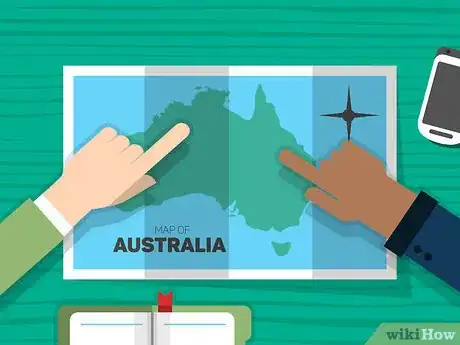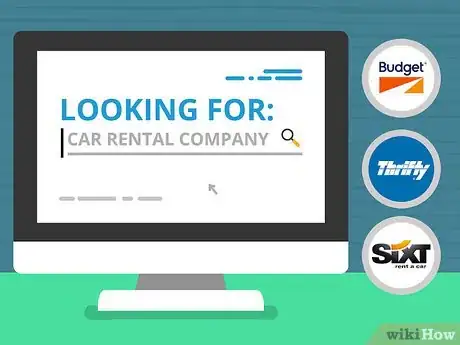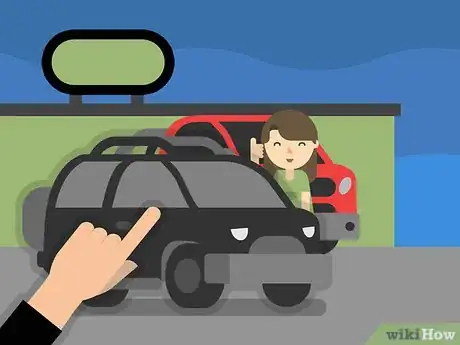wikiHow is a “wiki,” similar to Wikipedia, which means that many of our articles are co-written by multiple authors. To create this article, 12 people, some anonymous, worked to edit and improve it over time.
There are 10 references cited in this article, which can be found at the bottom of the page.
This article has been viewed 22,732 times.
Learn more...
Renting a car is an excellent way to make a vacation more comfortable or get off the beaten path. If you're traveling to Australia, renting a car (or "hiring a car" to the locals Down Under) will allow you to experience more of the country's expansive and majestic beauty. This guide will give you several tips to rent a car in Australia. It will acquaint you everything from rental and traffic laws in Australia to booking a rental car, picking it up, and enjoying your trip!
Steps
Preparing to Rent
-
1Familiarize yourself with the requirements. Before you rent a car in Australia, acquaint yourself with laws and requirements for renting, or "hiring," a car. Not only will this help you decide if you qualify to rent a car in Australia, but also whether or not it is a feasible option for your trip.
- You must be at least 21 years of age to rent a car. Some companies charge drivers between the ages of 21 and 25 an extra fee. Some also have a maximum age limit of 75.[1]
- You must have a valid driver's license for the type of car you want to rent. If you are from an English speaking country, all you need is your license. If your driver's license is in a language that is not English, you must have an international driver's license in addition to any non-English language one. Australian car rental companies do not accept probationary licenses (or driver's permits) or photocopies of licenses. The website dmv.org has information on how to obtain an international driver's license as well as a list of FAQ's on international driving.[2] [3]
- Auto insurance is required to rent a car. Companies require two policies: Collision Damage Waiver and Theft Insurance. Collision Damage Waiver, which costs approximately $10-30/ day, reduces any deductible you might owe the rental company in the event of an accident.[4] Theft insurance covers the loss of the car itself and not any of your belonging in it.[5] However, there are optional policies for personal accidents and personal effects. Inquire with your rental company for more information on this.
- Rental companies do not allow their cars on ferries. They also may forbid driving rental cars into or out of certain areas including Tasmania, Western Australia, the Northern Territories, and New Zealand.[6]
- Seat belts are required, and there is no tolerance for drunk driving.
-
2Consider the relevant geography. Australia is a large country, and places that may look close on a map are actually hundreds of miles away. Mapping out possible excursions is advisable. Consider this as you decide where to drive and rent your car.
- For example, Sydney to Melbourne is 860km (534 miles), while Sydney to Perth is 3,942km (2450 miles).[7]
- Australia has a great road network. Outside of cities in areas known as the Outback, though, roads may be dirt and there can be long distances in between cities or town or even the next fuel and food stops. The Australian Travel and Tourism Network has several different road maps of Australia you can consult and includes information on toll roads.[8]
Advertisement -
3Know the local rules. There is some basic information about Australia and driving there to know before you book. Wikitravel has an excellent, in-depth article on everything from driving in the Outback to traffic accidents and animals you may encounter on road trips.[9]
- Australians drive on the left hand side of the road. The steering wheel is on the right hand side of the car. Driving in Australia will require you to shift how you drive from turning, exiting highways, and passing other vehicles. You need to be comfortable with this change and can always drive on smaller roads for a couple of hours once you pick up your car to acclimate yourself to the new driving conditions.
- Australia uses the metric system. Speed and distance signs are in kilometers. Fuel (called petrol) is sold in liters.
Booking a Car
-
1Make arrangements in advance. You can either rent your car online before you depart or rent at a car rental company once you arrive in Australia. It's generally significantly less expensive, though, to book online or by phone with a rental company before you depart. Rental companies will often "sell out" of cars and may not have a vehicle for you, or one that is in your price range, if you wait to rent a car until you arrive.
-
2Find a car rental company. There are innumerable companies from which to rent a car either online, by phone, or in person. Most major car rental companies have offices in Australian cities and at airports from where you can pick up your car. These include Budget, Sixt, and Thrifty. There are also local Australian car rental companies. The Australian Travel and Tourism Network can direct you to one of these companies, which are often dependent on where you wish to rent.[10]
- If you're looking for the best value on renting a car and insurance, check the prices of different companies and renting in different locations. It's often less expensive to rent in a city than at an airport. Major rental car companies have websites that provide information and a portal for making a car rental reservation. Using travel websites such as Kayak or Expedia will allow you to compare prices on one site.[11] [12]
- Consult travel reviews if you want more information on companies or their policies. Tripadvisor has the comments of persons who have rented cars in Australia. Their experiences can give you an idea of which companies have the best policies and prices.[13]
-
3Compare offers. Once you've identified a few car rental companies, compare their prices and policies. Prices can vary greatly from company to company, so it's in your best interest to look at several options. Make sure to read the fine print on items such as insurance, fees, and mileage. Note that most companies require a credit card and will not accept debit cards with credit card logos.
- Some companies will not include the price of insurance or fees in their offer, making it appear less expensive. Acquaint yourself with each company's insurance policies and fee structure. You may be able to get a better rate for insurance through your personal insurance or credit card company.
- Some companies don't offer one-way rentals, or picking up a rental car in one city and dropping it off in another city. The company may also charge a fee for a one-way rental. If you want to drive from Sydney to Perth, for example, make sure the company offers one-way rentals as well as for this distance.
- Not all rental car companies offer unlimited mileage on rentals. If you're driving long distances, make sure to check that the offer you choose has an unlimited mileage option. Otherwise, you could end up with a car that allows only 300km per day with a high fee for any miles beyond that you drive, which could get very expensive.
- Make sure to read any fine print on the offer. It's important to read the entire offer so that you don't encounter any surprises once you pick up your car. The fine print will give you information on everything from insurance policies, administrative fees, and mileage limits.
- Additional drivers may cost more money. Many rental companies have an additional daily fee for each extra driver.
-
4Make and confirm reservation. Once you've found an offer that best suits you, you're ready to travel and enjoy the comfort your rent car brings.
- Print out your rental car information and confirmation once you've booked. If you book over the phone, write down the details including the confirmation number. You can also ask for an email confirmation or one in the post. Having this information will help you once you arrive to pick up your rental car.
Picking up Your Rental Car
-
1Take your documents. As you prepare for your trip, make sure to take all documentation required by the car rental company with you. Many companies will also ask for a copy of your passport.
- Keep a copy of your booking confirmation with you. This will eliminate any questions on items such as the price, dates of rental, or mileage limits.
- If you rent a car without a reservation, take your personal documents as well. Renting without a reservation can be more expensive than booking early. If you arrive at a rental car company without a reservation, prepare yourself that they may not have any available for when you want.
-
2Ask questions. Ask the rental agent any questions you have about the car, driving in Australia, fuel, rest stops, or even your rental agreement.
- Ask if the car is automatic or stick shift. If you can't drive stick shift, make sure to let the rental agent know so they can book you an automatic vehicle. Be aware that many companies outside of the United States charge extra for automatic vehicles.
- Ask about what kind of fuel the car requires. It may need diesel fuel instead of unleaded gas. Ask the agent if there is a map of fuel stops (called filling stations) in Australia as they may be far apart. BP and Shell both offer fuel finders for Australia.[14] \
- Ask if the car has any known damages. Your rental agreement should have these listed. If they don't, make sure the rental agent notes them so you do not get charged for damages you didn't incur.
- Ask questions about your insurance policy. Make sure you have the minimum Collision Damage Waiver and Theft Insurance. You can then decide if you would like to add policies that cover theft of your personal items, which may be covered by your personal insurance or credit card company. Inquire in advance to learn your different insurance options.
- Rental companies often have driving maps for clients. If you don't have a map or forgot to bring one with you, ask your rental agent if the company offers free maps or more detailed road maps you can purchase.
-
3Check the car. Checking over the car in the rental agency's parking lot is a great idea. Taking these few minutes can save you many headaches and a lot of money.
- Ensure that there is no damage that isn't already listed on the rental agreement. If you see anything not listed on the rental agreement, let the rental agent know. This will save you from being charged fees for damages you didn't incur.
- Ask any additional questions you might have about driving the car or how it functions.
-
4Practice. Plan to practice before you set out on a full day of driving or in areas of heavy traffic. This step is important if you're not used to driving with the steering wheel on the left hand side of the car as well as on the left side of the road.
- Taking a little time to practice this new skill is advisable. It can save you from making mistakes that may cost you time or money, or even from causing an automobile accident.
References
- ↑ http://www.kemwel.com/rental-car/Australia-driving.cfm
- ↑ http://www.dmv.org/international-driver-permits.php
- ↑ http://www.kemwel.com/rental-car/Australia-driving.cfm
- ↑ https://www.ricksteves.com/travel-tips/transportation/car-rental-cdw
- ↑ https://www.ricksteves.com/travel-tips/transportation/car-rental-cdw
- ↑ http://www.kemwel.com/rental-car/Australia-driving.cfm
- ↑ https://wikitravel.org/en/Driving_in_Australia
- ↑ http://www.atn.com.au/maps/australian-road-maps.html
- ↑ https://wikitravel.org/en/Driving_in_Australia





































































